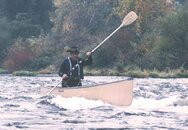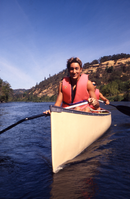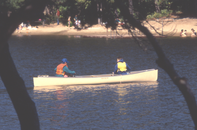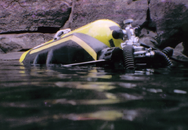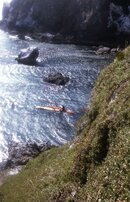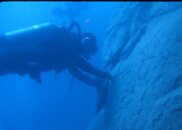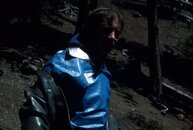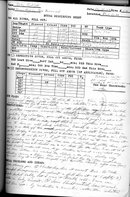For those of you who prefer kayaks, we used to have boats made specifically for diving and spearfishing. Shown here is a paddleboard I used in the 1960s for free diving for fish. It could hold a single steel 72 tank in the center section too. But apparently, those are no longer available.
I really like my Wenonah canoe, and don't plan to give it up for a kayak anytime soon. Rather than that, if I get into really wild water, I'll simply buy the
floatation bags for them. I really like the idea of outriggers for this canoe too. So maybe this is my winter project.
As you can see, I solo paddle this canoe with a double-bladed paddle in current. I can go upstream is small rapids with this technique. I always kneel when doing this, as it is much more stable, and provides more control of the canoe. Wenonah now makes a
thigh strap system that gives even better control of the canoe when kneeling. The paddle I use is made from two different kayak paddles. The center section is for a longer paddle, and then I put two kayak paddles on it so that I can paddle from the center-rear section of the canoe, using the rear thwart as my "seat." It works extremely well.
I remember one trip where we rented a Gruman canoe and took our dive gear to the opposite side of
Blue Lake in the Oregon Cascades. I did an experiment to see whether using a space blanket would provide any more protection from cold than the underwear inside a dry suit (it doesn't).

The dive was very interesting, as we entered the caldera of the lake from the southwest side, and onto a vertical drop-off. We It was a great dive in a wonderful setting, made possible by the use of the canoe. Here's part of my dive log entry:
Dive Plan: The plan was to dive to ~75'. Time was unspecified. We carried tables (both altitude and "no-calculation") plus twin tanks. Carried a marked line to show depth.
Observations:
Get into the water w/ the full-face mask (w/had a protective neoprene around the skirt) mounted on my Trieste II double hose regulator (reg. w/ octopus, power inflate & submersible gauge) in place and it felt like I was still in air, except that I was weightless. It was really nice to have no cold shock whatsoever. Descended to ~30' & found I was heavy, & so took off two pounds from weight belt. Bruce wanted a pre-dive briefing & so we surfaced and decided no a 75' max depth & 30". (This works out to 100' for 50"). I got to 75' & looked up to see Bruce at ~40' signaling me to come up. Tom was daving trouble getting down. At this point Bruce & I decided on a 40' max for this dive. Even at 75' I could barely make out some large boulders w/ were at ~120 ' which may have been bottom. We worked the cliffside on the dives, finding very interesting fissures and ledges. Al/so saw a forked tree top (tree must have been ~200' long at ~2[' from horizontal angle). Another interesting sight were the pale-green underwater moss that we saw at the 20-40 foot level. Took a lot of pictures of this & it should be interesting. Cut the dive at 60" to undergo decompression. During decompression we (Bruce and I, Tom had surfaced --40' for 50") created an underwater slide of large proportions. It began small but grew until it was a large cloud as it rolled over the cliff side at ~40 feet. It started in a large fissure at ~15 feet. Also saw a school of whitefish at 10' when on decom. Hopefully got a couple of pictures.
This dive occurred on May 25, 1975. Since we were planning to dive to 75 feet, on our decompression tables that was an 80 foot dive. We were at 3500 feet of altitude, which with the altitude correction factor I was using at the time made it a 92 foot dive, so we said we were diving to 100 feet on the schedule. I have an area of my dive log which is for listing "Special Problems and Ideas." Here's what this one said:
Special Problems and Ideas
1. Dive planning poor. 2. Aborted deep dive at correct time. 3. Took prescribed decompression for almost a full dive at 75' (safety +). 4. Suit leaked badly, but I wasn't terribly cold--Bruce was colder in leaky Unisuit. 5. Space blanket material doesn't work. Heat lass apparently by conduction and convection rather than radiation.
The marked line was because we recognized that our depth gauges would not tell us true depth, and we didn't want to use a calculation while in the water.
SeaRat




